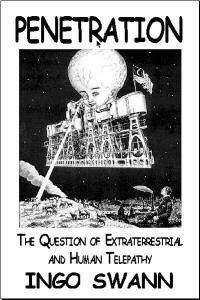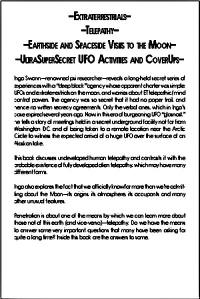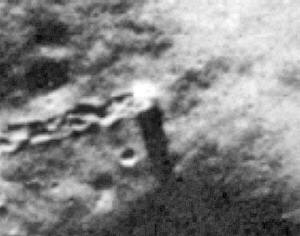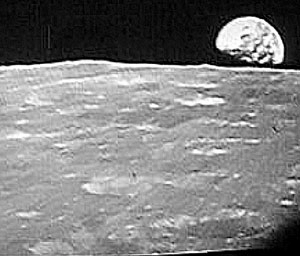|

Contents
Astounding Moon
Footage - Comment
Back to Contents
Astounding Moon Images - 2006 Update
from
ShadowBoxEnterprise Website
The L.E.M.U.R. team stirred enormous interest by presenting images
from the August, 2003 issue of Electric Space Craft, a scientific
journal.
The publication contained an amazing series of frames taken
from NASA imagery included in the TV program, NOVA: To the Moon. The
significance of the images had only recently been noticed.
As Apollo 8 orbited 70 miles above the lunar surface, with Earth in
the background,
it took images of the ground below. At one point in
the NOVA program, a small, black object, tall and cylindrical,
appears to be jutting from the moon. Just as it looks like the
camera is about to pass by, the strange object seems to release a
jet-like cloud.
It can be described as appearing like a smokestack
ejecting a puff of smoke. The “cloud” drifts to the right and then
dissipates. Though the black object appears small on the screen, it
would have to be hundreds or thousands of feet tall if it were
indeed seen from such a high altitude.
Included below are the black and white stills used in the
Electric
Space Craft issue. We have assembled these into an animated gif that
reproduces the NOVA footage. The black and white stills are frames
from the footage, posted in order from left to right. As you can
see, the anomaly first appears near the center of the frame, then
descends toward the lower left-hand corner as the camera moves
forward. The additional color stills were sent to us by the
publication.
Electric Space Craft increased the sharpness and contrast of the
black and white pics to clarify the scene for printing (however, you
can see the actual footage yourself if you purchase a copy of NOVA:
To the Moon, on VHS or DVD). The journal’s Executive Editor (and
former Apollo engineer), Charles A. Yost, said the anomaly is
clearer on the VHS version due to digital compression for the DVD.
The object appears on screen for two seconds, and was not mentioned
in the NOVA program. It was apparently unnoticed until spotted by
Electric Space Craft staff. At first glance, the anomaly does not
appear to be lint or debris on the film since it can be seen in many
frames, changes as the camera’s perspective is altered, and produces
the inexplicable cloud-like form that drifts and vanishes.
After posting this information, our Discussion Board was overwhelmed
with a firestorm of discussion and controversy.
Here are some new
thoughts brought up by some Discussion Board participants:
1. In the fifth frame, right as it
looks like the “smokestack” releases the “cloud,” a small, black
object, that looks like a projectile of some kind, can be seen
in line with the "jet-like cloud." This caused some to speculate
the anomaly could have been a firing weapon.
2. Other participants noted that a “cloud” on the moon would not
drift in such a manner due to the moon’s atmosphere.
3. However, the most interesting new information was presented
by
Phil Plait of www.BadAstronomy.com. One of his board’s
participants said the footage isn’t actually footage: he
believes it is a still photo that NOVA zoomed into to create the
illusion of motion. If so, that would mean the anomaly was
created by NOVA’s camera, and was not on the moon.
Mr. Plait
discovered an Apollo 8 photograph that seems to match the scene
containing the anomaly. Even though the photograph he found is
overlaid nicely with the anomaly scene on his site, the image is
highly pixilated and very poor quality when enlarged to the same
size as our original frames, hindering an exact comparison. If
anyone has a higher quality copy of this photograph, please send
it to us for analysis.
Jay Windley of
www.Clavius.org sent an
email to Charles Yost detailing why he felt the explanation
originally presented by Plait was correct.
Afterward, Yost said he
also feels this is the correct explanation, and the mystery will be
labeled as “solved” in the next issue of Electric Space Craft.
According to NASA, they did not have a color motion picture camera
with a zoom on the Apollo 8 mission. The image in question shows
clear evidence of a zoom. Therefore, unless there was a camera
on-board that NASA kept secret, this zoom effect should not be seen.
There are people who claim NASA had lots of secret cameras on-board,
but if so, then why did this “secret” footage fall into the hands of
NOVA? It is curious that zooming in on a photograph would create
such a strange anomaly, and we’d love to hear thoughts on what the
anomaly might be.
We have received emails from many who think the footage was either
accidentally used, or slipped in by a subversive staff member of the
program. They think NOVA and NASA are in cahoots! Of course, those
of that mindset would be virtually impossible to convince of a
conventional explanation.
2006 UPDATE
In 2006,
L.E.M.U.R. learned from a
NASA affiliate (whose connection
to NASA was independently confirmed) that top NASA officials
privately claim this footage is indeed legitimate.
However, certain
aspects related to this footage are highly classified, and the
matter is under investigation. There are some officials who want to
publicly comment on this subject, but currently do not have
clearance. If all this is indeed correct, what does this mean? If
the
Apollo 8 footage shows a tall smokestack-like anomaly filmed in
the 1960s, WHO put it there? And why should ANY footage from the
moon be classified?
It was announced in January of 2006 that Russia plans to build a
base on the moon by 2015 in order to
mine the precious helium 3, a
substance that facilitates nuclear fusion. There is enough on the
moon to power the entire earth cleanly and efficiently for thousands
of years.
A single space shuttle load could power the United States
for a year.
"Helium 3 fusion energy may be the
key to future space exploration and settlement," said Gerald Kulcinski, Director of the
Fusion Technology Institute (FTI) at
the University of Wisconsin at Madison.
"Helium 3 could be the
cash crop for the moon," remarked Kulcinski, a longtime advocate
and leading pioneer in the field, who envisions the moon
becoming "the Hudson Bay Store of Earth." Today helium 3 would
have a cash value of $4 billion a ton in terms of its energy
equivalent in oil, he estimates. "When the moon becomes an
independent country, it will have something to trade."
Source:
Back to Contents
Penetration - The Question of Extraterrestrial and Human Telepathy
1998
from
CourtneyBrown Website
Ingo Swann’s book, Penetration, is a nonfiction remote-viewing
thriller if there ever was one.
Ingo Swann
is one of the more important historical figures in the
U.S. government-funded efforts to investigate the phenomenon known
as "remote viewing." His participation in highly classified research
is now public knowledge and not disputed. Mr. Swann is also somewhat
elderly as of this writing, and I can find no reason for him to lie
now about what happened to him during his most bizarre interactions
with elements of the U.S. intelligence community.
Penetration is Mr. Swann’s most riveting book. The first 100 pages
of the book is just about guaranteed to keep any reader flipping the
pages as fast as the eye can read. In this book, Swann forever
banishes the idea that a remote viewer’s life need be
dull. This is
a story of how badly the government needed to know some information,
and to what extent it was willing to go to get it.
I suspect that
most readers will be grateful that Mr. Swann finally decided to tell
this most intimate history of his involvement with those in our
government whose activities only rarely become visible to the common
citizen.
 
Minimally, this is a story about
remote viewing and its use by Mr.
Swann to explore the idea of extraterrestrial life.
On the surface,
this would be interesting enough for many readers to want to hear
what he has to say. But Mr. Swann’s tale is not of a coolly academic
nature. Rather, he tells of how in the past he interacted with some
of the most deeply buried U.S. government intelligence personnel to
help them understand the "ET enigma."
This is not a story of
academic researchers wanting to know if extraterrestrial life is
possible. This is a nonfiction drama involving elite elements within
the U.S. intelligence community wanting to know more about
extraterrestrials whom they knew were operating on and near Earth.
This is the UFO hypothesis turned fully
around into a confrontation with reality that destroys more passive
"what-if" scientific speculation. From Swann’s perspective, it is
not a question of whether or not UFOs and extraterrestrials exist,
or whether or not the U.S. government knows about them. Rather it is
a question of how intensely the intelligence apparatus of the
government is trying to learn more about the activities of the
extraterrestrials without letting the public in on the story.
Mr.
Swann gets caught in the middle, a middle from which he eventually
escapes with the publication of this book.
This book is essentially
two books in one.
The first is about 100
pages long, and it details Mr. Swann’s interactions with U.S. spies
who study extraterrestrials. This is where the action and drama in
this book resides. After this the book shifts gears to more general
discussions (and speculations) about the subjects of telepathy,
remote viewing, and extraterrestrial life. In all honesty, the
latter parts of this book are not as interesting as the first 100
pages.
Perhaps some readers will find the later pages helpful not so
much because of what is said, but because of who is saying it.
Nonetheless, I doubt many readers will criticize Mr. Swann for the
later sections of the book given the visceral reward of the first
part.
This book will not convince anyone that extraterrestrials exist.
Rather, this book is for those who simply want to hear more about
Mr. Swann’s past. The fact that his involvement with the U.S.
intelligence community is already so well documented lends
credibility to his discussion in these pages. But this is not the
smoking gun that will force the government to reveal all. The story
in this book is too wild for the masses to embrace, and it is
unlikely that the government would ever confirm what Mr. Swann
writes about here, especially if it is true.
My suggestion is that readers take this book at face value, neither
accepting it fully nor rejecting it as impossible. This is Mr.
Swann’s story, his own personal story. It may be true. On the other
hand, some may conclude that it is either false or delusional. Since
it is impossible for most readers to know for certain one way or the
other, it makes more sense to simply accept this story as an honest
statement that is as true as Mr. Swann can remember it.
At least it
does not hurt us to keep our minds open.
Mr. Swann has contributed
so much to our current understanding of the human psyche and the
process of remote viewing, it seems only reasonable that people
should give him the courtesy of allowing him to tell this most
personal and intense story. As a society, we owe him that much at
least. On the other hand, we owe him a lot more if what he writes
about in Penetration is a true recollection from his past.
One side note, this book is somewhat hard to obtain since it is
self-published. Interested readers may want to go to Mr. Swann’s web
site to find out how to obtain this book.
Back to Contents
Ingo Swann
Gets Feedback Regarding Naked Men on The Moon
Remote viewer sees more than a "man in the moon"
4/27/2000
from
AlienZoo Website
Naked male workers working under bright lights on the moon, tall
buildings, exotic machinery, and strange vehicles leaving tracks in
the lunar dust - all this and much more was seen by Ingo Swann,
the man most responsible for the phenomenon known as remote viewing.
Swann was invited to take a mental look at the moon by a man
he knew only as Mr. Axelrod. This man might have been a
real-life counterpart of the cigarette-smoking man of X-Files fame.
Mr. Axelrod claimed to be part of an ultra-secret government group
investigating alien activities on both the moon and the Earth. This
actual "man in black" took Swann, blindfolded, to an
underground government facility and had him agree to a remote
viewing session.
Remote viewing is a psychic method of acquiring intuitive
information about people, places and things. It was researched for
more than a quarter of a century, first by the CIA, and later by the
U.S. Army, which created a unit of operational remote viewers to spy
on the old Soviet Union and others. Swann, who coined the
name "remote viewing" as an alternative to the term "clairvoyance,"
studied the phenomenon at
Stanford Research Institute and
helped train many of the Army’s viewers.
During his remote viewing for Mr. Axelrod, Swann
realized he was viewing scenes on our moon, but not anything
remotely like the moon that we have learned about. He saw water
and a weak atmosphere on the moon, essentials for life. He
also saw structures, machinery, bridges,
tracks, and other evidence of an active presence on this
supposedly dead world.
His incredible adventure with Mr. Axelrod
and the Moon is detailed in Swann’s 1998 book
Penetration:
The Question of Extraterrestrial and Human
Telepathy.
But, as in so many bizarre remote viewing sessions, Swann received
no immediate "feedback" following his strange mental vision of the
moon. Swann himself has stated that without adequate feedback, no
remote viewing can be said to have taken place. It was about a year
later when Swann felt as though he finally got feedback on his
strange mental journey to the moon.
It came in the form of a book published in 1976 titled
Somebody Else Is On The Moon, by George H. Leonard.
The book arrived in the mail with no return name or address.
In this
book, almost impossible to find today, Leonard reproduced many NASA moon photographs as well as tapes from
Apollo missions
and concluded that,
"a highly advanced underground
civilization is working the surface of the moon - mining,
manufacturing, communicating, and building!"
"Leonard’s book was filled with verifiable data, official
photos, and sketches of structures, etc., he created from the
photos," stated Swann. "Many of Leonard.s sketches
resembled some of mine."
"Yes indeed, the mysterious Mr. Axelrod had provided me
feedback as promised, for there could be no doubt that it was
his jolly self that sent Leonard’s book to me."
Swann’s adventure with the moon
occurred in 1975-76. Since then, several other authors
claimed to have found the same evidence as Swann and Leonard,
regarding aliens on the moon.
In 1982, author William L. Brian II in his book,
Moongate - Suppressed Findings of the U.S.
Space Program, detailed information about activity on the
moon and posited,
"In all probability, the United
States manned exploration of space never stopped after the
Apollo missions. It is an interesting possibility to consider
that Russia might be sending cosmonauts on extended trips to the
moon or other planets for up to six months using the Salyut 6
space station as a cover. Of so, what might the United States be
doing, and could the Space Shuttle Project be another decoy for
military space operations?"
By 1990, author Fred Steckling
had printed five editions of his book,
We Discovered Alien Bases on the Moon,
a collection and analysis of 125 official NASA photographs.
Steckling too concluded there was water, atmosphere, even
vegetation on the moon and, after a careful examination of the
photos, concluded,
"There seems to exist a tremendous
technology on the moon."
Since the books mentioned above are hard
to locate, current researchers might study the second revised
edition of the 1995 book by David Hatcher Childress’s,
Extraterrestrial Archeology,
available through Adventures Unlimited Press. This book is
rife with NASA photos, drawings, and maps detailing what the author
says are pyramids, domes, robot mining vehicles, tunnels, bridges,
and other structures on the moon.
Most compelling is a NASA blowup (NASA, VII Gassendi S 2.4
- click below images) which shows
two rounded objects leaving tracks across the lunar landscape.
The
larger object leaves behind irregular track marks, while the smaller
object appears to have rolled up the side of a moon crater, then
moved down the crater and out onto flat ground, leaving behind a
slightly curved track.
 
Also fascinating are other photos. NASA
No. 16-18918, which clearly shows a large oval object jutting out
over the lip of a large moon crater, and No. 16-19265, which seems
to show a large circular/domed object nestled next to 10
regularly-spaced objects, in what appears to be a partially
underground hangar.
In 1968, a year before U.S. astronauts landed on the moon, NASA
published Technical Report R-277, titled Chronological Catalogue
of Reported Lunar Events, which lists more than 570 moon
anomalies from 1540 to 1967.
Some of the more intriguing events in
this study include:
-
A "star" was seen within the
body of a crescent moon "directly between the points of her
horns" on March 5, 1587.
-
During March and April of 1787,
Britain’s Sir Frederick William Herschel, pioneer of the
reflecting telescope and discoverer of Uranus, claimed to
have sighted three "bright spots," four "volcanoes," and
lights moving "above the moon".
-
In July 1821, a German
astronomer reported sighting "brilliant flashing light
spots". His was one of numerous reports of flashing or
blinking lights seen on the moon.
-
In February 1877, a line or
streak of light was seen stretching across the crater
Eudoxus. This light was observed for about an hour, ruling
out the possibility that it was merely a meteorite striking
the lunar surface with a flash.
-
Two steaks of medium intensity
light were recorded on June 14, 1940, in the crater Plato, a
location where reports of lights have numbered in the
thousands.
-
A "black cloud surrounded by
violet color" was seen in the Sea of Tranquility by Canadian
astronomers on September 11, 1967.
-
New York Herald Tribune science
editor John J. O’Neill on July 29, 1953,claimed to have seen
a 12-mile-long "bridge" straddling Mare Crisium. After
reporting his find to the Association of Lunar and Planetary
Observers, O’Neill was scorned by astronomers.
However, a
month later, the "bridge" was confirmed by British
astronomer Dr. H.P. Wilkens, who told the BBC,
"It looks artificial. It’s
almost incredible that such a thing could have been
formed in the first instance, or if it was formed, could
have lasted during the ages in which the moon has been
in existence."
Further confirmation came from Patrick
Moore of the British Astronomical Association, who declared the
"bridge" had "popped up" almost overnight.
Such Lunar Transient Phenomena (LTP) are
well known among veteran astronomers. Bright and blinking lights,
colorful displays, clouds, or mists have been reported in many lunar
craters, especially those of Aristarchus, Plato, Eratosthenes, Biela,
Rabbi Levi, and Posidonius.
Then there are the numerous NASA photos of UFOs both on and near the
moon.
A 1972 16mm film taken from Apollo 16 (NASA File Roll 9361)
clearly depicts a spherical craft with a domed top, flying far over
the moon’s cratered surface. Just as amazing are photos of gigantic
cigar-shaped objects traversing the moon’s face in NASA No. 16-19238
and 11-37-5438. A Lunar Orbiter IV photo (No. LO IV 89-H-3) depicts
a large, cigar-shaped object reflecting light while sitting on the
surface near the crater Romer.
One thing seems clear - the moon is far from being a dead world.
Something is happening on our moon, something so profound that,
despite our capability for further exploration, we are prevented
from returning.
Back to Contents
|














